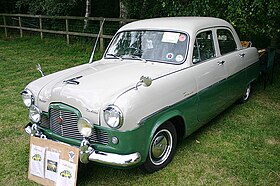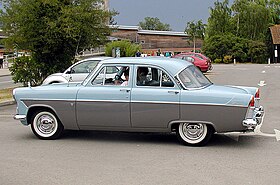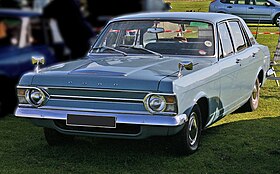Ford BA Falcon
 | |
| Manufacturer | Ford Motor Company of Australia |
|---|---|
| Production | September 2002 – October 2005 |
| Assembly | Campbellfield, Victoria, Australia |
| Predecessor | Ford AU Falcon |
| Successor | Ford BF Falcon |
| Class | Full-size car |
| Body style | 2-door ute 4-door sedan 5-door station wagon |
| Layout | Front-engine, rear-wheel drive |
| Platform | Ford EA169 |
| Engine | Straight-6
|
| Transmission | 4-speed automatic 5-speed manual 6-speed manual |
| Wheelbase | 2,829 mm (111.4 in) |
| Length | 4,916 mm (193.5 in)–5,053 mm (198.9 in) |
| Width | 1,864 mm (73.4 in) |
| Height | 1,444 mm (56.9 in) |
| Curb weight | 1,620 kg (3,600 lb)–1,740 kg (3,800 lb) |
| Related | Ford Fairlane Ford Fairmont Ford Territory |
The Ford BA Falcon is a full-size car, produced by the Ford Motor Company of Australia between September 2002 and October 2005. The exterior styling of the BA was a substantial revision of that used for the preceding AU model, every panel except the 4 door skins was newly designed. A new independent rear suspension setup was fitted to all sedan derivatives, and the engine and transmission received extensive upgrades. In late 2004, Ford introduced a Mark II update, bringing subtle styling and mechanical changes,and twelve months after that, replaced the BA with the BF. The model's market share briefly topped that of its chief competitor, the Holden Commodore on two occasions, but have failed to match those of the record-breaking EL Falcon.In the final months of 2002, the BA model received the influential Wheels Car of the Year award,breaking a 36-year drought.The BA also won four consecutive Australia's Best Cars awards, spanning three years.
Development and design
The BA model represented a A$ 500 million investment, and 24,000 hours of engine and durability testing. Germany’s Nürburgring test track was used for some suspension testing. The anti-lock brakes and electronic stability control were calibrated in Sweden, as well as Australia.
Exterior design
Exterior styling was led by design director Scott Hamilton, then chief designer for Ford Australia. After Scott departed from operations at Ford in 2001, Simon Overland took over this role.Ford Australia's intention was to create a European influence for the vehicle, whereby most aspects of the AU's "New Edge" design would be revised. The result was a significant update of the existing AU body shell, rather than a completely new design.The BA model introduced an integrated aerial in the car’s rear window, instead of the conventional retractable antenna. The aerial placement improved the vehicle's aerodynamics and ended the breakage issues that had plagued the retractable type found on previous models. Interestingly, interference from the engine did not affect the radio reception.
Interior design
From the inside, the "New Edge" interior of the AU was discarded in favour of a contemporary style, based upon European designs. Marcus Hotblack, the director of interior design, focused on improving user friendliness. The resulting design was an ergonomically-correct interior command centre, highlighted by the satin-finish centre console. The theme was further extended by the audio and cruise control switches' location on the steering wheel.
A prominent feature of the new command centre was a large liquid crystal display which displayed information regarding the air conditioning unit and sound system. Buyers could opt for a premium sound package, standard on the Fairmont Ghia, which included a full-colour screen.Ventilation outlets were larger than those of previous models, resulting in a cabin that could be more effectively and efficiently heated or cooled. Another change was the headlamp switch, which was now located on the end of the turn signal stalk for easier reach.
Interior colour schemes varied from model to model, but shared a common design approach. The entry-level XT featured a black plastic panel for the upper half of the dashboard, with either a black, charcoal, or beige panel for the lower half. Not all variants offered the distinctive colour palette; the sports variants could not be optioned with the two-tone interior.
Engine and mechanicals
Powerplants consisted of both straight-sixes and V8s, with the entry-level Barra 182 six-cylinder being a significant improvement over the AU Falcon's six, with a gain of 25 kilowatts (34 hp) of power for a total of 182 kilowatts (244 hp). The Barra 182 can also take advantage of higher octane fuels, where a small increase of torque can be achieved. The 156-kilowatt (209 hp) LPG-only Barra E-Gas engine was offered as an option on lower specification models.
A turbocharged variant of the Barra engine was introduced in a new XR6 Turbo model and produced 240 kilowatts (320 hp) of power.A 5.4 litre V8 replaced the Windsor engine of the AU. The new V8 was a modified version of Ford's North American Modular V8 available in two variants: the Barra 220 generating 220 kilowatts (300 hp) and a 260 kilowatts (350 hp) Boss 260.The new engine was smoother, more fuel efficient, and quieter than the engine it replaced.
| Engine | Power | Torque |
|---|---|---|
| 4.0 L Barra 182 I6 | 182 kW (244 hp) | 380 N·m (280 lb·ft) |
| 4.0 L Barra E-Gas I6 | 156 kW (209 hp) | 372 N·m (274 lb·ft) |
| 4.0 L Barra 240T I6 | 240 kW (320 hp) | 450 N·m (330 lb·ft) |
| 5.4 L Barra 220 V8 | 220 kW (300 hp) | 470 N·m (350 lb·ft) |
| 5.4 L Boss 260 V8 | 260 kW (350 hp) | 500 N·m (370 lb·ft) |
Two transmissions were available for the BA—a four-speed automatic and a five-speed manual, both floor-mounted. The automatic unit featured Sequential Sports Shift, a first for the Falcon nameplate in Australia. Utility body styles were also available with an optional column-mounted automatic shifter (without Sequential Sports Shift) in lieu of the floor-mounted system also offered. The new Control-Blade independent rear suspension (IRS) fitted to all sedans—first used in development of the Ford Focus and the Jaguar X-Type— was superior to the optional double wishbone IRS suspension used on AU sedans, and was cheaper. However, it was heavier than the previous live rear axle used for base models, and the change contributed to the base model XT sedan's 130 kilogram (287 lb) weight increase from the previous model. The wagons and utilities retained the leaf spring live axle rear suspension of the AU wagon and utility; consequently, they did not gain as much weight as the sedan.
The BA Falcon was also smoother on the road, with increased towing capabilities from previous models. Fuel consumption in the Barra 182 was measured at 12.5 L/100 km (18.8 mpg-US) for city driving and 8.2 L/100 km (29 mpg-US) for highway driving. These numbers were government figures, measured indoors using a dynamometer. Real-world testing has shown that an extra 12% is actually consumed.
Safety
Passenger safety was a key design aspect for the Ford engineers. Anti-lock brakes were standard on all models; electronic brakeforce distribution was also standard on most variants. The addition of traction control for higher trim levels helped to prevent loss of traction. On top of this, dual front airbags were a standard fitment across the range; with side-impact airbags being equipped on higher luxury levels such as the Fairmont. In a crash safety assessment conducted by ANCAP, the BA model scored 27.27 out of a possible 37 points, giving a rating of four out of five stars.
Specification levels
| Year | Units sold |
|---|---|
| 2002 (October–December) | 17,500 |
| 2003 | 73,172 |
| 2004 | 65,384 |
| 2005 (January–September) | 39,967 |
| Total | 196,023 |
Falcon XT
Marketed largely towards the fleet industry, the entry-level Falcon XT sold in the most numbers.Featuring the base Barra 182 six-cylinder engine, air conditioning, front power windows, and five-speed manual, with the choice of a four-speed automatic, the XT was sold in sedan and station wagon body types.Judges of the Australia's Best Cars awards crowned the XT Best Family Car in 2002, and again in 2004,with the Futura receiving the award in 2003.
Futura
The semi-luxury Futura variant was heavily based on the XT, and marketed towards families. Futura models gained cruise control, 16 inch alloy wheels, rear power windows and full body-coloured side-view mirrors and side-protection moldings. But, side-impact airbags and power adjustable pedals were only available as options.
Falcon XR6
Building on the features of the XT, the sports orientated Falcon XR6 was at one point considered not to be released. This was because of the new XR6 Turbo model, however, Ford overturned this decision before production. A specifically designed body kit distinguished the XR6 from other variants, except for the XR6 Turbo and XR8 which shared the sports bodywork. The naturally aspirated engine was identical to the engine used on the XT and Futura, and the five-speed manual transmission came as standard.
The newly introduced Falcon XR6 Turbo (XR6T) received critical acclaim at launch, and the Australia's Best Car's judges even awarded it the Best Sports car under $57,000 in 2002.At heart visually identical to the XR6, the turbocharged derivative gained extra features, with the additional turbocharger boosting the car's total power output to 240 kilowatts (320 hp). The turbocharger is a Garrett GT35/40 unit.
Falcon XR8
Being the flagship sports variant, the XR8 credited specially tuned sports suspension, seating trim displaying the "XR" insignia, 17 inch wheels and the new 5.4 litre Boss 260 engine, outputting 30 percent more power the previous model.
Fairmont
The Fairmont model opened up the luxury sector for the Falcon nameplate. Externally, the Fairmont could be distinguished from the other BA models with its 16-inch alloy wheelsand grey mesh grille with chrome surround. Some of the standard features included traction control and dual-zone climate control air conditioning, an analogue clock on the top centre console stack, wood grain highlights,and velour upholstery.AutoLamp automatic headlights, which turn off or on depending on surrounding environmental conditions, were now standard on the Fairmont model.In addition to this, the Fairmont also received illuminated footwells. The basic mechanical setup carried over from the XT, although buyers could opt for the Barra 220 V8 engine.
Fairmont Ghia
By far the most expensive variant in the BA range, the Fairmont Ghia featured leather upholstery, wood grain highlights, full power options and a unique suspension assembly. The premium sound system, which incorporated a full-colour LCD screen, was standard, and the centre console stack was characterised by an analogue clock.Reverse parking sensors were available for the first time in the BA, standard on the Ghia. The sensors feature an automatic turn-off function for use when towing a boat or trailer for example.
Falcon Ute
The BA series Falcon utility was introduced in October 2002 in six models guises.
- XL Cab Chassis
- XL Styleside
- XLS Cab Chassis
- XLS Styleside
- XR6 Styleside
- XR6 Turbo
- XR8: re-introduced to the range early in 2003 (last seen in the previous AU III series).
- RTV: was released in September 2003. The name "RTV" stood for "Rugged Terrain Vehicle" and featured an increased ride height, additional underbody protection, a lockable rear differential, a unique grille, flared guards and 16 inch alloy wheels. Originally dubbed "Hi-Ride" prior to release, in early 2003 Ford Australia held a competition to find a name for this variant, with "RTV" announced as the winning entrant in July.
Mk II
Ford released the Mk II (BAII) Falcon in October 2004 to maintain sales interest until the 2005 introduction of the BF update. Modifications included some cosmetic changes and a new six-speed Tremec T56 manual transmission replacing the five-speeder on XR6 Turbo and XR8 models. The Futura model gained power adjustable pedals, and side airbags, with a DVD entertainment system being offered on upmarket trim levels. The XR8 sedan variant also received the premium audio system.
Issues and criticism
Critics in the media noted BA's build quality faults, such as inconsistent gaps between trim sections and joints,although other commentators praised the interior design and craftsmanship. In the used car market, BA Falcons tend to suffer from poor depreciation rates, due to influxes of ex-fleet models entering the second-hand market and because of the cost of fuel.



































































![Validate my RSS feed [Valid RSS]](valid-rss-rogers.png)














































































